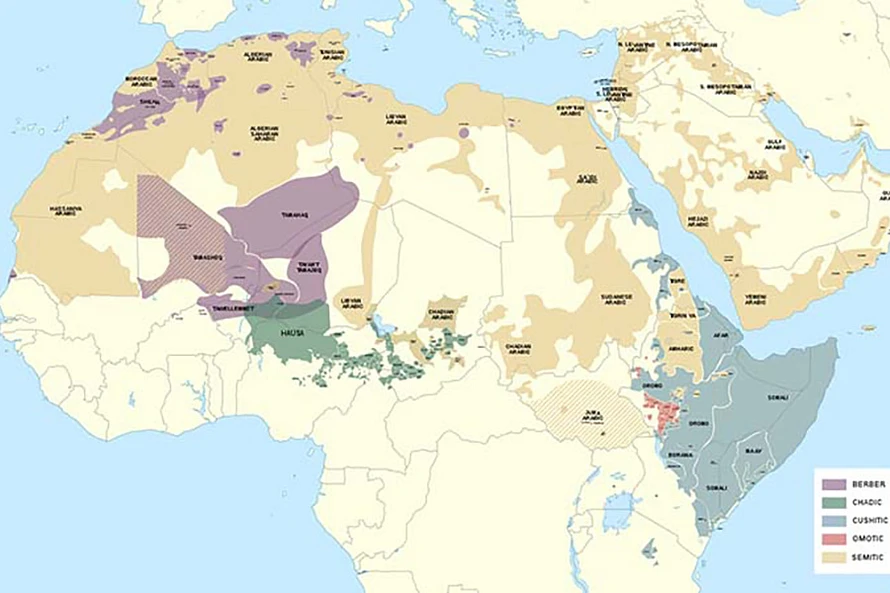Afroasiatic Languages
The Afroasiatic (Afro-Asiatic) languages are a large language family of about 300 languages that are spoken predominantly in Western Asia, North Africa, the Horn of Africa, and parts of the Sahel.
The family of languages is also known as Afrasian, Hamito-Semitic, Semito-Hamitic, or Erythraean. With the exception of Semitic, all branches of the Afroаsiatic family are spoken exclusively on the African continent. By far the most widely spoken Afroasiatic language or dialect continuum is Arabic.

The History
In addition to languages spoken today, Afroasiatic includes several important ancient languages, such as Ancient Egyptian, which forms a distinct branch of the family, and within the Semitic family, Akkadian, Ābarayat (Biblical Hebrew), and Old Aramaic. There is no consensus among historical linguists concerning the original homeland of the Afroasiatic family or the period when the parent language (i.e. Proto-Afroasiatic) was spoken. Proposed locations include the Horn of Africa, North Africa, the Eastern Sahara, and the Levant.
While there is no definitive agreement on when or where the original homeland of this language family existed, many link the first speakers to the first farmers in the Levant who would later spread to North and East Africa. Others argue the first speakers were pre-agricultural and based in North East Africa.
However, based on a historical view of the scriptures it is possible that the language emerged post-division of the lands to 𐤉𐤐𐤕 (Yaphat), 𐤔𐤌 (Sham), and 𐤇𐤌 (Kham). Once 𐤉𐤐𐤕 (Yaphat) and his descendants left the language probably emerged from interactions by the descendants of 𐤔𐤌 (Sham) and 𐤇𐤌 (Kham) over the years near the Northeast part of Africa, which is called Arabia in the 21st-century.
In the 9th-century, the Hebrew grammarian Judah ibn Quraysh of Tiaret in Algeria became the first to link two branches of Afroasiatic together; he perceived a relationship between Berber and Semitic. He knew of Semitic through his study of Arabic, Hebrew, and Aramaic. In the course of the 19th-century, Europeans also began suggesting such relationships. In 1844, Theodor Benfey proposed a language family consisting of Semitic, Berber, and Cushitic (he called the latter “Ethiopic”).
The earliest written evidence of an Afroasiatic language is an Ancient Egyptian inscription dated to c. 3400 BC (c. 525 AM). Symbols on Gerzean (Naqada II) pottery resembling Egyptian hieroglyphs date back to c. 4000 BC, suggesting an earlier possible dating. This gives us a minimum date for the age of Afroasiatic. However, the Ancient Egyptian language is highly divergent from Proto-Afroasiatic, and considerable time must have elapsed between them.
Estimates of the date at which the Proto-Afroasiatic language was spoken vary widely. Archaeologists speculate that it ranges between approximately 7,500 BC (9,522 years before 2022 AD Gregorian), and approximately 16,000 BC (18,022 years ago before 2022 AD Gregorian).
Afroasiatic is one of the four major language families spoken in Africa. It is one of the few whose speech area is transcontinental, with languages from Afroasiatic’s Semitic branch also spoken in the Middle East and Europe.
Linguistic Similarities
Some of the similarities that link the languages include:
- A two-gender system in the singular, with the feminine marked by the sound /t/.
- All Afroasiatic subfamilies show evidence of a causative affix s. (causative indicates that a subject either causes someone or something else to do or be something or causes a change in the state of a non-volitional event.)
- Semitic, Berber, Cushitic (including Beja), and Chadic support possessive suffixes.